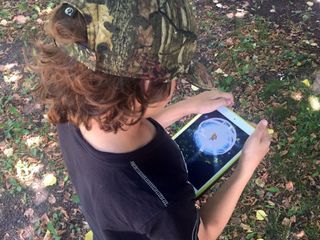
Pokémon Go is the augmented reality game everyone is talking about. To play, you go around searching in your neighborhood capturing and collecting pocket monsters. On the surface, it seems like the perfect game to get the kids out and exercising. But, as a parent, if your kids do go out to play Pokemon Go, there are some things you need to know!
Boundaries

As a parent, you need to set boundaries for your kids. That includes where they're allowed to play. Establish a safe area for your kids and make sure they stick to it. I typically choose parks or other areas away from busy roads.
It's easy for a child — even and adult! — to become distracted or figure they can dash across the street to get closer to a PokeStop. Keep them safe by keeping them away from potential danger.
Turning off sound helps a lot too. It means they have a better chance of hearing your instructions, and hearing cars, horns, and other warnings when out and about.
Likewise, set time limits. Let your kids know when they can start playing, and when they have to stop and go on to other activities, chores, and homework.
Stay lit
If your child is old enough to be out at night, or you're going out as a family, make sure everyone has clothing that includes a light. I use glow bands with my kids. That way I can always see where they are, and so can bicyclists, drivers, and other walkers.
Keep them dressed in light and bright colors as well. That way they'll reflect any light coming their way and have an even better chance of being seen.
Master your iPhone in minutes
iMore offers spot-on advice and guidance from our team of experts, with decades of Apple device experience to lean on. Learn more with iMore!
Don't catch and bike
Bikes, scooters, and other modes of transportation — including cars! — require complete focus and attention to operate safely. Make sure your child knows that, if they're riding, their device is off and safely put away.
Once they get to their destination they can take it out and start playing again. Until then, eyes and attention on what they're doing.
Stranger danger
One of the best things about Pokemon Go is how it brings people together in united purpose — catching pocket monsters! But that sense of community and openness to meeting new people absolutely does not extend to children.
Make sure your children know that they're not to follow anyone without you, even if that person promises to show them a rare Pokemon, or asks their help to find a PokeStop.
Just like kids need to be taught not to follow strangers for candy or to help find pets, they need to be taught not to follow them for Pokemon.
Keep them secret, keep them safe
Information is incredibly valuble. Don't let your child give up their privacy or identity just to play a game.
- Create a secondary, dummy Google account for them to play with. Something that doesn't tie back to a school account or actual, personal account.
- Don't let them use their real names for their Pokemon account names. Encourage them to use their creativity to come up with code names or Pokemon Trainer-style names.
That way, their data is safe and their identity is safe.
Use the buddy system
Pokemon are best caught in pairs or groups. Not only is it more fun for everyone involved, it's safer too. Especially for kids. If they're going out, make sure you or someone you trust go with them.
If they have data on their device, you can also turn it off and then tether them to your iPhone. That way, if they stray to far, they fall off the net. That encourages them to stay close, and closer is safer.
Sun and water

It can be hot out there, especially in summer. That means sunburn and heat stroke are real concerns. So, get a really good sunscreen and make sure your child applies it properly and often. A hat and sunglasses are important as well.
Also, make sure they have water with them, they stop and take a drink regularly, and they fill up when they need to as well. Occasional breaks are good for everyone as well, especially if you can get out of the heat and get some cool air and refreshment as well!
Trust... but verify
My colleague, Russell Holly, has some great tips for parenting Pokemon players on Android. My favorite is keeping track of exactly what your child is doing. That way, you know if they were following the rules you set out for them.
It's not about whether you trust your kids or not, it's about knowing that they're kids and they need supervision.
To find out how long your child is playing for:
- Launch Pokemon Go from your home screen.
- Tap the Player button at the bottom left of the screen.
- Tap the Journal button
Look at the times that your child was playing. If they match the limits you've set, great! If not, it's time for a talk.
Theoretically, you can also check location, though it doesn't seem to be working right now.
- Launch Pokemon Go from your home screen.
- Tap the Pokeball button at the bottom center of the screen
- Tap the Pokemon button at the bottom left.
- Tap on any Pokemon.
- Scroll down and look at the map to see where it was caught.
Watch for signs of addiction
Pokemon Go works on similar principles to casinos. You get a taste of winning, and so you feel like you need to keep playing. Watch your children after they play. If they become overly aggressive or belligerent, they might be playing too much or they might be having trouble controlling themselves.
In our house, the kids have to earn and pay for time playing video games. They do this through good behavior and doing homework.
Play, don't pay
Although Pokemon Go has in-app purchases, you really don't need them to play and enjoy the game. If you don't trust your child with an iTunes account, you can turn off in-app purchases in settings.
Bottom line
I hope that these tips will help you and your family enjoy Pokemon Go and stay safe. If you have any questions, or great parenting tips of your own to share, please leave them in the comments!
Senior Editor at iMore and a practicing therapist specializing in stress and anxiety. She speaks everywhere from conferences to corporations, co-host of Vector and Isometric podcasts, follow her on Twitter @Georgia_Dow and check out her series at anxiety-videos.com.
Most Popular




